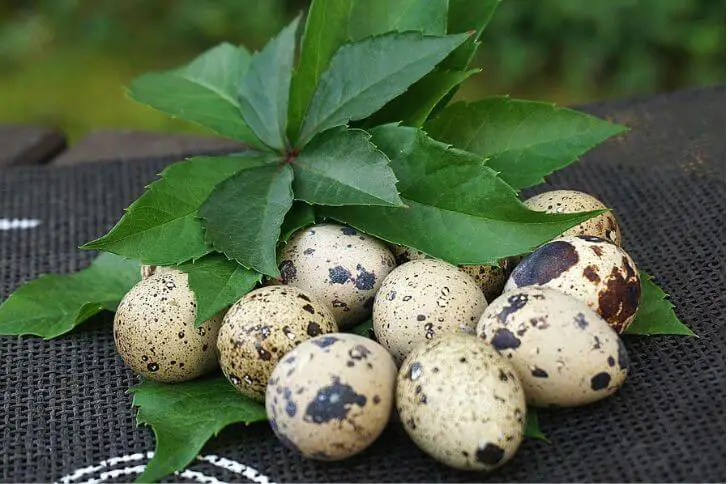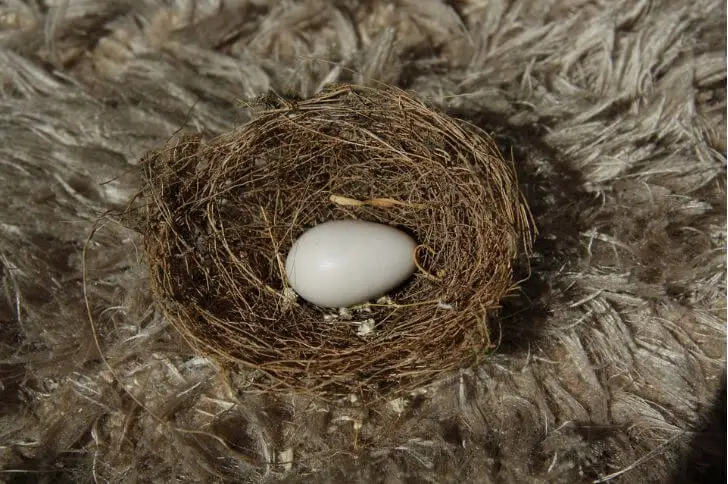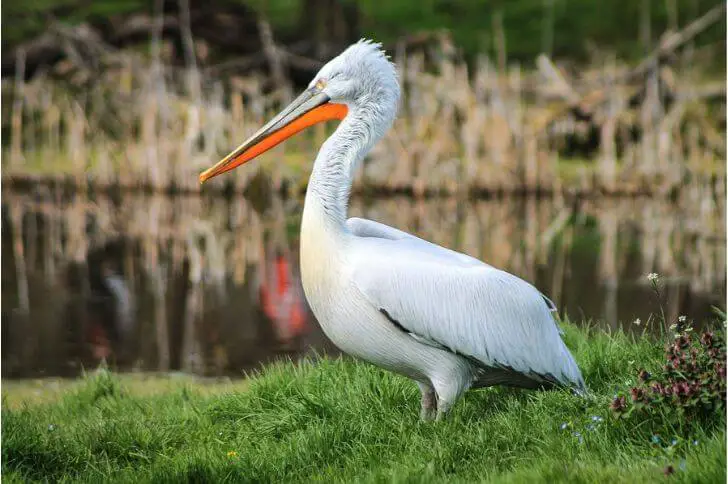The blue jay is a stunning bird with bright blue plumage. They are one of the most common birds in North America and can be found in wooded areas across the continent. Blue jays are known for their loud calls and interesting behaviors.
If you are wondering about the juvenile blue jay, keep reading the article below. We niche down to this small bird’s plumage, feeding habits and answer other questions you may have about it.
These intelligent birds are fascinating to watch and make great backyard birding companions.
What is a juvenile blue jay?
A blue jay fledgling is a young bird of the species Cyanocitta cristata. The plumage of this young bird is similar to that of an adult, but the birds are often smaller and have less distinct markings. Juvenile blue jays typically remain with their parents for several months after leaving the nest before striking out on their own.
What color are juvenile blue jays?
Juvenile blue jays are not actually blue. When they are born, they are covered in a grayish down and their eyes are closed. It isn’t until they reach six to eight weeks old that they start to develop the distinctive blue plumage for which they are known.
The color of a juvenile blue jay’s feathers is dull blue on the upperparts and grayish below. They do not have black necklaces that adults spot. Their bills and legs are dark.
Do juvenile blue jays have a crest?
Juvenile blue jays do not have a crest like their adult counterparts. The lack of a crest is due to the fact that these young birds haven’t reached sexual maturity yet. Once they reach sexual maturity, the crest will begin to grow in.
How can I tell if a baby blue jay is male or female?
While the birds are young, it is hard to distinguish between the sexes. But when they mature you can tell female blue jays from male by observing their behavior.
One way to tell the difference is by their call. Male blue jays have a louder, harsher call than females. Also, you can look at the bird’s size; males are slightly larger than female blue jays.
How big are blue jay juveniles?
In the world of blue jays, juveniles are on the smaller side. A juvenile blue jay will typically weigh between 1 and 2 oz. The average length of a robin fledgling is between 6 and 8 inches. The wingspan is also relatively small, measuring between 8 and 12 inches.
While juveniles are certainly not the biggest birds around, they are still quite impressive in terms of size. For example, a juvenile blue jay’s heart makes up about 4% of its body weight – which is significantly higher than the average for other birds or animals. Additionally, juveniles have a very high rate of metabolism, which helps them to grow quickly and develop into strong adults.
Related Read: Learn about robin juveniles
What do Juvenile blue jays eat?
The diet of a juvenile blue jay consists mainly of insects. They will also eat some fruits and nuts, but their primary source of food is protein from insects. This is why you will often see them foraging on the ground or in trees, looking for their next meal.
Insects are not only a good source of protein for juvenile blue jays, but they are also easy to catch. This is important because juveniles are still learning how to hunt and may not be successful in catching larger prey items. By eating lots of insects, juvenile blue jays can get the energy and nutrients they need to grow into healthy adults.
Blue jay parents will feed the baby for the first two weeks of its life.
When do blue jays molt?
As the weather starts to cool down in late summer, blue jays begin to molt. This process can take up to six weeks, during which time the birds will lose all of their feathers and grow new ones.
Molting is essential for the birds’ survival as it allows them to replace worn-out feathers and maintain their waterproofing. The new feathers are also necessary for insulation against the cold winter weather.
During molting, blue jay fledglings will often look disheveled and may even appear to be bald in spots. This is perfectly normal and nothing to worry about! The birds will gradually grow back their feathers until they are once again looking sleek and beautiful.
What sound do blue jay fledglings make?
When blue jay fledglings are first born, they make a soft “chirping” noise. As they grow older and learn to fly, their calls become louder and more harsh. Blue jays are known for their distinctive “jay-jay” call, but this is actually only made by adult birds.
So, next time you hear a bird chirping in your backyard, see if you can spot a blue jay fledgling!
How long is a blue jay a fledgling?
17-21 days. During this time both blue jay parents forage and feed these young jay. The family unit remains intact until the brood leaves the nest.
How long do juvenile blue jays stay with their parents?
Blue jays are very family oriented birds. The juveniles will stay with their parents until they are ready to leave and are strong enough to fend for themselves.
The length of time that the juvenile blue jays stay with their parents can vary depending on the availability of food and nesting sites. In some cases, the juvenile blue jays will stay with their parents for a month while in other cases up to two months.
When do baby blue jays leave the nest?
The average nestling period for a blue jay is 17-21 days. Most young blue jays will leave the nest before they are fully independent, but some may stay with their parents for up to 8 weeks before leaving the nest.
Some factors that may influence when a young blue jay leaves the nest include weather conditions and availability of food.
Do blue jay fledglings revisit their homes?
No, juvenile blue jays do not return to their home. Once they fledge, this birds are have scarce wings and are not able to fly back home. You’ll spot them perched on trees. After their feathers are grown and they are good at flying, they’ll find a roosting cavity and live there until they attain breeding age.
How long does it take for a blue jay to mature?
A blue jay typically takes about one year to reach full maturity. During this time, they will undergo a number of changes, both physically and behaviorally. For example, they will grow from a small, dull blue and gray bird into a vibrant blue adult.
They will also learn how to fly, hunt, and socialize with other members of their species. By the time they reach maturity, blue jays will have all the skills they need to survive in the wild.
What to do if you find a fledgling blue jay?
If you find a fledgling blue jay, the best thing to do is leave it alone. The bird’s parents are probably nearby and will take care of it. If you must move the fledgling, put it in a bush or tree close to where you found it. If you have a furry friend, cat or dog, keep them away from this area to protect the young birds.
What time of the year can you see young blue jays?
In late spring and summer, you may see young blue jays taking their first steps out of the nest. These fledglings are typically 4-5 weeks old and have not yet learned to fly. Instead, they cling to branches and hop around awkwardly. It is during this time that they are most vulnerable to predators.
If you see a young blue jay in distress, it is best to leave it alone. The parents are usually nearby and will take care of it. However, if the bird appears injured or sick, you can contact your local wildlife rehabilitation center for help.
Where do blue jays sleep?
In the wild, blue jays typically sleep in trees. They like to find a spot high up in the branches, where they can perch and keep an eye out for predators. Blue jays will also roost in man-made structures, like birdhouses, if there are no trees available.
In captivity, blue jays can be trained to sleep in a designated area. This might be a cage with soft bedding material, or a special perch with a built-in sleeping box. If you have a pet blue jay, make sure to provide them with a safe and comfortable place to sleep.
Do baby blue jays drink water?
Most birds need to drink water regularly to stay hydrated. Baby blue jays are no exception. They will drink water from a bowl or birdbath, or even from puddles on the ground.
In the wild, blue jays will also eat insects to get the moisture they need. However, baby blue jays are not yet able to hunt for their own food. That’s why it’s important for them to have access to fresh water every day.
If you see a baby blue jay at your bird feeder, make sure there is also a dish of water nearby. This will help the little bird stay healthy and strong until it’s old enough to fend for itself.
Sources:
https://www.audubon.org/field-guide/bird/blue-jay
https://en.wikipedia.org/wiki/Blue_jay
Hi fellow bird watcher. Welcome to our small corner of the world. At the spanishbirdguides.com our mission is to share with other bird watchers the things we love about birds, where to go bird watching within the United States, and more. I’d also love to hear from you. Feel free to contact me about your bird watching escapades, share videos, photos and more.



